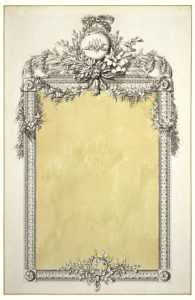Recovering Rocaille: Tracing Stylistic Imbrication in 18th-Century French Ornament Prints
EMERGING SCHOLARS > SUMMER RESEARCH GRANTS
by Ashley Boulden
A Decorative Arts Trust Summer Research Grant allowed me to undertake substantial research at the Morgan Library and the Cooper-Hewitt, Smithsonian Design Museum in New York City, as well as the Canadian Centre for Architecture (CCA) in Montréal, Canada. This object-based research engaged a selection of 18th-century publishers and designers central to my dissertation “Licentious Prints: The Persistence of the Rococo and the Malleable Antique in French Ornament Prints and Interiors, 1737–1788.” In particular, I examined and documented a wide body of prints and drawings that anchor my investigation of the circulation of ornament in this period, in which organic Rococo forms persisted long after scholars have suggested.
Beginning at the Morgan Library, I viewed Charles-Germain de Saint-Aubin’s rare watercolor title page lettered “Plantes et Fleurs Nature[lles] par Saint Aubin” from 1740 (figure 1) as well as his sets of floral monograms for embroidery patterns Premier and Deuxième Recueil de Chiffres from 1771. The watercolor, a rocaille title page for Saint-Aubin’s manuscript the Recueil de plantes, 1736–1786 (figure 2) was the missing link in my earlier research of the artist’s wider practice, allowing me to better understand the source material for his prints. Alongside these works, I viewed similar patterns by Pierre Ranson, an artist who worked in the manner of Saint-Aubin, and discovered that such objects circulated more widely than I had anticipated and that there was a significant market for this style.1
At the Cooper-Hewitt, I viewed a selection of prints and drawings for designing residential interiors by Neoclassical ornemaniste Richard de Lalonde in the 1780s (figure 3). Close material analysis of Lalonde’s ambitious presentation drawings allowed me to identify them as models for his asymmetrical, bimodal print designs Oeuvres diverses de Lalonde (late 18th century) and to carefully trace his process in staging viewer choice and activating taste in a manner that evoked an earlier Rococo tradition of active viewer engagement and discernment.
At the CCA in Montréal, I examined the extraordinary manuscript by Rococo ornemaniste Gilles-Marie Oppenord, Decorated Copy of Cesare Ripa’s Iconologie, c. 1713. Detailed analysis of Oppenord’s drawings, which were composed upon prints and later reconfigured by publisher Gabriel Huquier, allowed me to trace early experimentation within iconological pattern books in advance of architect and designer Jean-Charles Delafosse’s 1768 Nouvelle Iconologie Historique, a work that is central to my dissertation. Comparing the manuscript to Huquier’s later publications of Oppenord’s work at the CCA, including Œuvres de Gilles-Marie Oppenord and Premier—[onzième] livre de differents morceaux…, enabled me to identify earlier Rococo forms alongside the publisher’s own turn toward the Neoclassical later in his career.2 This research is central to my analysis of the porous boundaries of style at a moment of the cresting circulation and dissemination of prints for the decoration of Parisian interiors in the 1760s.
The Decorative Arts Trust Summer Research Grant enabled me to conduct research in these key North American collections in advance of extensive research abroad on a yearlong fellowship in Paris. Together, these trips have allowed me to hone my investigation of 18th-century stylistic imbrication and to recover the relationship between printed pattern books, decorative arts, and merchant shops in these decades. More broadly, I have continued to build a framework for examining sets of ornament sourcebooks that unsettle familiar stylistic distinctions between the Rococo and Neoclassicism in 18th-century Paris. I am most grateful to the members of the Decorative Arts Trust for making this research possible.
1 On Saint-Aubin and Ranson, see Mary Myers, Regency to Empire: French Printmaking 1715–1814. (Baltimore: Museum of Art, 1984), p. 212. Well-known for his 1748 series Papilloneries Humaines, vignettes of butterflies engaged in human activities, few scholars have turned to Saint-Aubin’s later work or noticed his subtle introduction of the antique into the visually deceptive and playful ornament typical of the French rococo tradition of the 1730s. pp. 37–43 discusses Huquier’s appropriation of Oppenord for the print market. My research is less focused on Huquier’s process and more concerned with tracking a longer history of stylistic interleaving.
2 Jean-François Bédard, “Prints by Gabriel Huquier after Oppenord’s Decorated ‘Ripa,’” Print Quarterly, vol. 29, no. 1 (March 2012).
Ashley Boulden is a PhD Candidate at the University of Virginia and a 2019 Summer Research Grant Recipient.
A print version of this article was published in The Magazine of the Decorative Arts Trust, one of our most popular member benefits. Join today!

![Figure 1. Charles-Germain de Saint-Aubin, “Plantes et Fleurs Nature[lles] par Saint Aubin”, 1740. The Morgan Library & Museum 1956.13. Purchased as the gift of the Fellows.](https://decorativeartstrust.org/wp-content/uploads/2020/01/print-figure-1-203x300.jpg)

